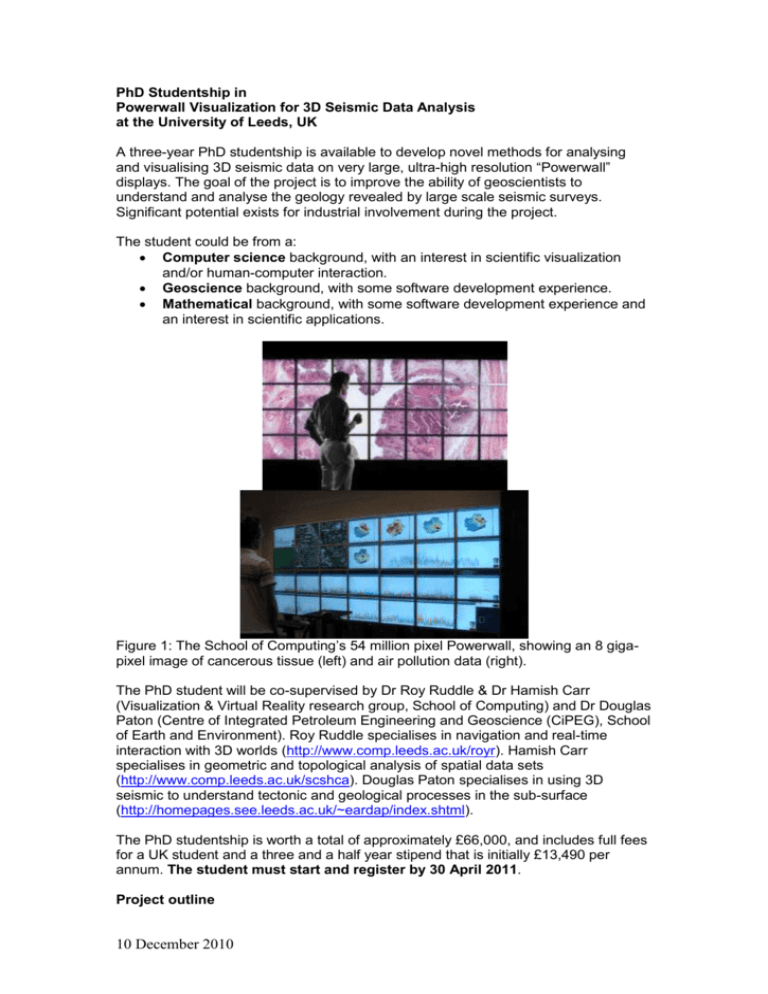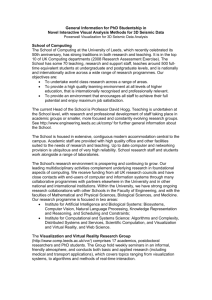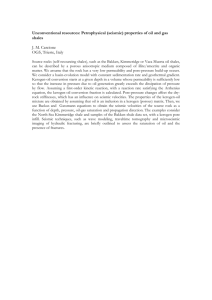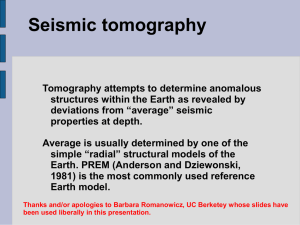PhD Studentship: Novel Interactive Visual Analysis Methods for 3D
advertisement

PhD Studentship in Powerwall Visualization for 3D Seismic Data Analysis at the University of Leeds, UK A three-year PhD studentship is available to develop novel methods for analysing and visualising 3D seismic data on very large, ultra-high resolution “Powerwall” displays. The goal of the project is to improve the ability of geoscientists to understand and analyse the geology revealed by large scale seismic surveys. Significant potential exists for industrial involvement during the project. The student could be from a: Computer science background, with an interest in scientific visualization and/or human-computer interaction. Geoscience background, with some software development experience. Mathematical background, with some software development experience and an interest in scientific applications. Figure 1: The School of Computing’s 54 million pixel Powerwall, showing an 8 gigapixel image of cancerous tissue (left) and air pollution data (right). The PhD student will be co-supervised by Dr Roy Ruddle & Dr Hamish Carr (Visualization & Virtual Reality research group, School of Computing) and Dr Douglas Paton (Centre of Integrated Petroleum Engineering and Geoscience (CiPEG), School of Earth and Environment). Roy Ruddle specialises in navigation and real-time interaction with 3D worlds (http://www.comp.leeds.ac.uk/royr). Hamish Carr specialises in geometric and topological analysis of spatial data sets (http://www.comp.leeds.ac.uk/scshca). Douglas Paton specialises in using 3D seismic to understand tectonic and geological processes in the sub-surface (http://homepages.see.leeds.ac.uk/~eardap/index.shtml). The PhD studentship is worth a total of approximately £66,000, and includes full fees for a UK student and a three and a half year stipend that is initially £13,490 per annum. The student must start and register by 30 April 2011. Project outline 10 December 2010 3D seismic data analysis is central to the petroleum industry’s discovery of new oil and gas fields. Current analysis methods are very time consuming and labour intensive, and the sheer size of the datasets (80 gigabytes is common) makes visualization difficult. Efficient analysis of 3D seismic data presents fundamental computing and application challenges, which we will address in the following ways. 1) How can we harness the huge display space of Powerwalls, to dramatically reduce the time that human experts need to analyse 3D seismic data (this draws on Ruddle’s expertise)? 2) What new algorithms can we develop, to allow efficient exploration of complex data sets (e.g. to reduce visual clutter due to occlusion) and automate the extraction of significant features (topological, geometric, etc.)? This draws on Carr’s expertise. The results will be put into a geoscience/hydrocarbon industry context, drawing on Paton’s expertise. Several 3D seismic data sets are available to the project, ranging from 6 Gb to 80 Gb in size. Knowledge & skills required The student will have a 1st or upper second class degree or MSc in a discipline such as Computer Science, Geoscience or Mathematics. The key knowledge and skills required for this PhD are listed below. The student will already have some of these, and should acquire the others during their PhD (e.g., by participating in Computing and Geoscience taught modules): Software development (C++/C) Interactive 3D computer graphics (OpenGL) Human-computer interaction (interface design & user evaluation) Good mathematical ability (seismic analysis algorithms) Aptitude for understanding geophysics domain problems Excellent verbal and written communication skills How to apply Potential applicants are encouraged to make informal enquiries to Roy Ruddle (r.a.ruddle@leeds.ac.uk) or Hamish Carr (h.carr@leeds.ac.uk). Please see the studentship web page for application details. Training and Career Prospects The project will involve an innovative collaboration between the School of Computing and the School of Earth and the Environment. Depending upon the PhD student’s background appropriate training will be given to ensure sufficient knowledge in both disciplines. As it is likely that the student will have a computing background a variety of modules from relevant undergraduate and MSc modules within the Earth Sciences will be available. At the end of the project the student will have a solid understanding of large-scale scientific visualization in addition to a solid grounding in Geophysics/Geosciences and therefore be well placed for a career either in research or in the petroleum industry. 10 December 2010







